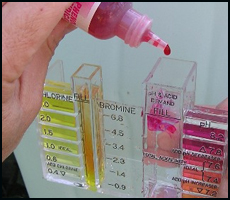Mantaining Your Pool
[download id=”5″ format=”1″]
Pool Start-up
Read entire label of each pool chemical and use in accordance with
precautionary statements and directions. Pool chemicals can be
dangerous if used improperly. All chemicals should be handled by
adults only, and kept out of the reach of children. Filter system must always be on and running when adding chemicals to pool. All chemicals must be added to pool separately and must not be mixed together.
For existing pools, remove cover, connect filter to pool and remove any winter plates and plugs. Add water if needed, and clean and vacuum pool.
 Step 1: Make sure pool is filled up to the top of the skimmer opening. Refer to instructions supplied with pool filter if you have questions.
Step 1: Make sure pool is filled up to the top of the skimmer opening. Refer to instructions supplied with pool filter if you have questions.
Step 2: Follow directions on test strips and use test strips to measure the total alkalinity of the pool water and adjust to proper range of 80 to 120 ppm. Add Aquamate Alkalinity Plus (to raise alkalinity) or Alka Down (to lower alkalinity) as necessary, following directions and precautionary statements on container.
Step 3: Use test strips to measure the pH level of the pool water and adjust to proper range of 7.2 to 7.8. Add Aquamate pH Plus (to raise pH) or pH Minus (to lower pH) as necessary, following directions and precautionary statements on container.
Step 4: Add liquid shock by pouring into skimmer with filter running (Liquid Shock is purchased separately from the Pool Opening & Maintenance Kit , or is supplied with new pool package) at a rate of 1 gallon per 5000 gallons of pool water. Granular shock can be substituted for liquid shock, follow directions and precautionary statements on container.
Step 5: Add 10% Algaecide per directions and precautionary statements on container.
Step 6: Continue to run filter at least 8-12 hours.
Step 7: Use test strips to make sure that chlorine level is in safe range of 1-3 ppm (this usually takes about 12-24 hrs after adding shock). Add chlorine stabilizer at a rate of 8 oz per 3000 gallons. Follow directions and precautionary statements on container.
Step 8: Add 2oz of Super Clarifier per 5000 gallons. Follow directions and precautionary statements on container.
Step 9: Begin adding your regular dose of chlorine sanitizer (i.e. Chlorine powder or tablets) to keep your chlorine level in the safe range on your test strip. Follow directions and precautionary statements on container (Chlorine sanitizer is purchased separately from the Pool Opening & Maintenance Kit, or is supplied with new pool package.)
Pool Maintenance
Step 1: Always keep chlorine level in the safe range on your test strip. Test after daily. Run your pool filter at least 6 to 8 hrs every day.
Step 2: Test and adjust Total Alkalinity and pH levels weekly. Follow directions and precautionary statements on container.
Step 3: Add maintenance dose of 10% algaecide, follow directions and precautionary statements on container.
Step 4: Add 2 oz of Super Clarifier per 5000 gallons of pool water each week. Follow directions and precautionary statements on container.
Tips: Rain, hot weather, and heavy use affect you pool water’s chemistry. Generally, you will need to add more chlorine and run filter longer after rain, hot weather or heavy use. Rain also usually causes Alkalinity and pH levels to go down, which causes cloudy water. Test your Alkalinity and pH levels after it rains. Shocking the pool with liquid shock weekly or every other week will also help keep your pool sparkling clean.
Pool Volume in Gallons
| Round Pools | Capacity (Gallons) | Oval Pools | Capacity (Gallons) |
| 10 Round | 2,000 | 8x12,8x14 | 3,000 |
| 12 Round | 3,000 | 8x19 | 3,500 |
| 15 Round | 5,000 | 10x15, 10x16 | 3,500 |
| 18 Round | 7,500 | 10x21, 12x18 | 5,000 |
| 21 Round | 10,000 | 12x24, 14x20 | 7,500 |
| 24 Round | 14,000 | 14x25, 15x24 | 10,000 |
| 27 Round | 18,000 | 15x30, 16x26 | 12,000 |
| 30 Round | 21,000 | 16x32 | 15,000 |
| 18x33 | 19,000 |
Note: Pool volumes above are approximate. For exact calculations please use the calculator below.




